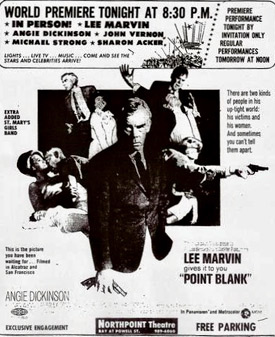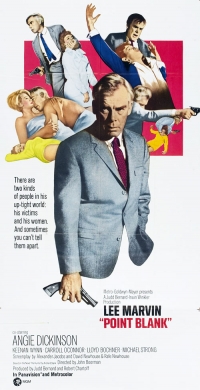Dwayne Epstein is the author of Lee Marvin: Point Blank (Schaffner Press, 2013) and member of the BSOL (Bastard Sons of Lee Marvin). He is also the author of a number of young adult biographies covering such public figures as Hillary Clinton, Will Ferrell, Nancy Pelosi, Adam Sandler, Hilary Swank, and Denzel Washington for Lucent Books’ People in the News series and the multiple biography Lawman of the Old West for Lucent’s History Makers series. Epstein also contributed to Bill Krohn’s Hitchcock at Work (2003) and Joe Dante and the Gremlins of Hollywood (1999). He has also written for Filmfax Magazine and Cahiers du Cinema and is currently writing “a logical follow-up to” Lee Marvin: Point Blank.
Michael Coate (The Digital Bits): How do you think Point Blank should be remembered on its 50th anniversary?
Dwayne Epstein: In remembering the importance of any groundbreaking film, it’s necessary to always put it in its proper historical context. In the case of Point Blank, 1967 was a year in which many long-held cultural taboos were shattered in mainstream films thanks to the end of the studio system and old production code. By 1967 both style and subject matter were constantly being challenged on a regular basis throughout the year (Bonnie and Clyde, In the Heat of the Night, The Dirty Dozen) and riding the crest of those taboo-breaking films was Point Blank.
Coate: Can you recall the first time you saw Point Blank and what is your opinion of the film?
Epstein: I first saw the film in its entirety at the Los Angeles County Museum of Art (LACMA) at a special screening with some friends and it featured a Q&A with its costar, Angie Dickinson. I didn’t particularly care for it at first, having seen it cut up on TV the first time. However, like many great films, it has grown on me in time to become one of my personal favorites. There are too many reasons to go into as to why it’s grown on me. Suffice it to say, with all great works, more great things are discovered upon each viewing of this multi-layered classic, making continued viewing a new discovery each time.
Coate: Is Point Blank a significant motion picture in any way?
Epstein: The highly stylized film boasts many technological advancements, as well as some of the most memorable images of its kind. The reverberating sound of Marvin’s heels echoing through the airport during the opening, or the juxtaposing of a brutal fistfight during a hip, soul music riff still pack a significant wallop. Although it is not widely known, Point Blank is also the first film to mic all the actors individually during a scene, thereby incorporating a greater sense of intimacy.
Here’s an anecdotal example of the film’s lasting significance. One of the film’s most iconic images of both violence and sexual power, as recalled by Boorman, was a collaborative effort: “It was Lee’s idea to shoot into the empty bed of the wife who had betrayed him. We were using blanks which give no recoil, so, Lee faked it, his arm whipping back a foot or more with each shot. It suggested the enormous power of the thing more than anything else could. Later, when we were filming on Alcatraz, we got some live ammunition and fired the big Magnum for real. There was no recoil at all. Lee grinned at me. ’Our way sure beats the real thing,’ he said.”
The production was also the first ever shot with extensive sequences on the then recently decommissioned prison of Alcatraz. The difficult task of obtaining permission to shoot on “The Rock” was secured by promising government officials that the film would not glorify crime. Once that was accomplished, the filmmakers took over the decaying prison, shooting long into the night. One shot included a love scene between Marvin and actress Sharon Acker in what had been the cell of Al Capone. At one point, the production almost lost a script girl who slipped on an oil-slick barge into San Francisco Bay’s choppy waters.
 Coate: In what way was John Boorman an ideal choice to direct Point Blank, and where do you think the film ranks among his body of work?
Coate: In what way was John Boorman an ideal choice to direct Point Blank, and where do you think the film ranks among his body of work?
Epstein: First and foremost, the entire project was Boorman’s idea. He approached actor Lee Marvin about it when Marvin was filming The Dirty Dozen in England. Once Marvin agreed, the project moved ahead as Boorman envisioned it. The British director has since carved a career out of exploring and juxtaposing man’s relationship and conflict with his primal self, most prominently with his classic 1972 film Deliverance. In my opinion, Deliverance ranks only slightly ahead of Point Blank in the director’s impressive canon of work, both different genres with the very similar themes mentioned herein.
Coate: Can you discuss Lee Marvin’s performance? In what way was he ideal for the role of Walker?
Epstein: At the time of the film’s production, the actor’s marriage was on the rocks while he was in a tumultuous relationship with then girlfriend, Michele Triola. “I saw Point Blank about a year ago and I was absolutely shocked,” he said in 1985. “I had forgotten how rough a film it was. That was a troubled time for me in my personal relationship so I used an awful lot of that while making the picture.” Rarely has art imitated life so creatively.
Coate: Can you discuss Angie Dickinson’s performance? In what way was she ideal for the role of Chris?
Epstein: She fit the part first and foremost based on her look which was in perfect unison with the time. She is also an underrated actress who played the role subtly falling for Lee Marvin’s Walker following her sister’s death. Despite Lee Marvin not having many leading ladies, he worked most with Dickinson and with good reason. Their chemistry was palpable.
It was Dickinson who made a pointed observation when Point Blank was screened at LACMA: “It’s been taken to task for its violence but if you notice, Lee’s character never really kills anyone, except for a car and a bed. He really is a catalyst for violence, not a perpetrator.” Her observations gives credence to those film buffs who argue that Marvin’s character is actually the Angel of Death. As with most great films, the strange concept of the film is open to the audiences’ own imagination.
Coate: Where does Point Blank rank among the noir/crime genre?
Epstein: I would rank it extremely high as its influence is still very much in evidence. It’s interesting that it received tepid reviews when it first came out but it has since gone on to garner cult film status. At the time of its release, most critics dismissed it but some, such as Newsweek, wrote: “It hits like a slug from the .38 Lee Marvin uses as extension of his fist. It is highly moral violence with compelling photography.” Point Blank has since gone on to attain justifiable cult status. The highly stylized camera work, coupled with Marvin’s raw performance has made it, in the words of film historian Leonard Maltin, “A taut thriller ignored in 1967 but now regarded as one of the top films of the mid-sixties.”
Many of the films made since have been directly influenced by it, such as Quentin Tarantino’s Reservoir Dogs in 1992 and Pulp Fiction two years later. There were also more obvious examples, such as Mel Gibson’s 1999 remake Payback and Jason Statham’s Parker (2013).
Coate: What is the legacy of Point Blank?
Epstein: It was and remains what it was when first released: The first art house action film.
For more information concerning the film’s production and lasting impact, consult my book, Lee Marvin: Point Blank for even greater insight into what made it such a haunting cinematic achievement worthy of its inclusion into the National Registry of Films in 2016.
Coate: Thank you, Dwayne, for sharing your thoughts about Point Blank on the occasion of its 50th anniversary.

IMAGES
Selected images copyright/courtesy Metro-Goldwyn-Mayer, Warner Home Video, Winkler Films.
SPECIAL THANKS
David Smith
- Michael Coate
Michael Coate can be reached via e-mail through this link. (You can also follow Michael on social media at these links: Twitter and Facebook)




